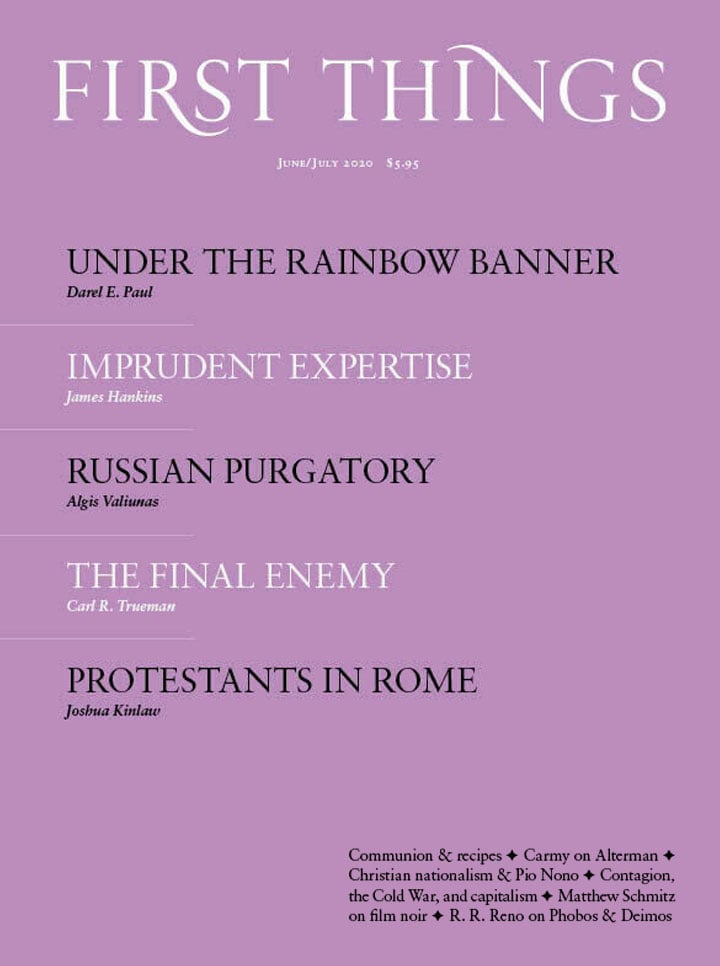In the mid-1940s, Hollywood began to make a new kind of crime film. Combining sex and violence, lust and greed, the “noir” was distinguished by the darkness of its themes and photography. Double Indemnity (1944) was, as a critic noted in the New York Times, “the first of the new rough, tough murder yarns.” Fred MacMurray played Walter Neff, a solitary insurance salesman whose recreations include bowling alone. Unable to resist femme fatale Phyllis Dietrichson (Barbara Stanwyck), he agrees to kill her husband.
Double Indemnity established the template shared by every pure noir: A well-meaning but weak-willed man meets a dangerously attractive woman. Preferring her company to any prior bond or higher duty, he becomes complicit with her in wrong. Death is the inevitable result. In some noirs, flashbacks are used to dramatize the inexorable way that death follows transgression, or voice-overs are employed to highlight the man’s knowledge that he is making a fatal mistake. Among the finest films of this type are Criss Cross (1949), Out of the Past (1947), and Scarlet Street (1945).
Detective films such as The Maltese Falcon (1941) and The Big Sleep (1946) are sometimes classed as noirs. Based on stories by Dashiell Hammett and Raymond Chandler, they feature a latter-day knight errant who moves coolly from case to case and woman to woman. Double Indemnity was different. It was based on a novel by James M. Cain, who put perpetrators rather than investigators at the center of his crime stories. Cain’s heroes do not love and leave women. They stay with them “all the way to the end of the line.” They do not risk their lives by investigating crime; they forfeit their souls by committing it. Only stories with such high moral stakes provide a contrast between good and evil stark enough to match the high-contrast visual style of film noir.
Noir juxtaposes light and shadow, day and night. A more typical Hollywood picture of the 1940s achieved a harmonious look by a careful balance of light. In this “high-key” style, the harsh shadows produced by the bright “key light,” which shone directly on the actor, were reduced by the use of a soft, indirect “fill light.” Noir films, by contrast, were “low-key.” Key lights were employed with relatively little fill, creating dramatic pools of shadow.
Many of the creators of noir—Fritz Lang, Robert Siodmak, and Billy Wilder among them—were émigrés from Germany or Mitteleuropa. They brought to Hollywood their knowledge of German expressionism, which employed surreal sets and effects to manifest inward realities. Noir sought the same object by more realistic means. To a degree uncommon in Hollywood film, the makers of noir used lighting, smoke, and scenery to create natural-seeming scenes evocative of interior states such as guilt and anxiety.
John Alton, the greatest noir cinematographer, perfected these methods. By lighting a face from an unusual angle, for example, he created bizarre shadows that exaggerated or obscured an actor’s features. Alton described this as “criminal lighting.” It “distorted the countenance,” showing how evil deforms our humanity. Composition could be used in the same way. Rather than placing the hero and femme fatale in a balanced “two shot,” noir directors tended to arrange them in off-kilter arrangements suggestive of discord and instability.
Noir’s visual language was well suited to depicting moral realities in a fallen world where good and evil, darkness and light, run through all of life. Its most typical setting is southern California, a place that Cain archly named “Paradise.” The inhabitants of this would-be Eden keep reenacting the Fall.
Like Adam in the Garden, the noir hero starts out lonely. “I lived a lonely life. I had no friends,” says Erich von Stroheim’s character in The Great Flamarion (1945). But it is not good for man to be alone. Along with Milton’s Adam, the noir hero can “taste / No pleasure, though in pleasure, solitarie.” As Jeff Bailey (Robert Mitchum) says in Out of the Past, “Nothing in the world is any good unless you can share it.”
Once he has found the femme fatale, the noir hero will not part from her, even when he knows he should. “The man could not bear to be severed from his only companion,” Augustine said, “even though this involved a partnership in sin.” Walter Neff tries to forget Phyllis Dietrichson, but “the hook [is] too strong.” Frank Chambers (John Garfield) flees the woma, but he “just [can’t] get her out of [his] mind.” These men choose to be complicit rather than lonely. “How can I live without thee?” Milton’s Adam asks Eve. “From thy State / Mine never shall be parted, bliss or woe.”
Just as Adam preferred the company of Eve to the friendship of God, the noir hero endangers prior relationships through his complicity with the femme fatale. He betrays old friends (Double Indemnity, Gun Crazy, Please Murder Me), cheats on his wife (Pitfall, The File on Thelma Jordon, Night Editor, Nora Prentiss, The Woman in the Window, Scarlet Street), abandons his girlfriend (Angel Face, The Killers), kills his colleague (Pushover).
What St. Paul said of Adam is true of the noir hero: He is not deceived. Even as he makes the fatal choice, he knows the folly of what he is doing: “I knew I had hold of a red-hot poker, and the time to drop it was before it burned my hand off” (Walter Neff); “I knew where I was and what I was doing, and I knew I was a sucker for it” (Jeff Bailey); “If I stayed there, I could see where she and I were headed” (Frank Chambers).
But the noir hero feels trapped by fate. “From the beginning, it all went one way. It was in the cards, or it was fate, or a jinx,” Burt Lancaster’s character says in Criss Cross. “Fate, or some mysterious force, can put the finger on you or me for no good reason at all,” Tom Neal’s character says in Detour (1945). Milton’s Adam speaks as if his choice were predetermined: “I with thee have fixt my Lot, / Certain to undergoe like doom.” This feeling of powerlessness is typical of fallen man. “The will is truly free when it is not the slave of vices and sins,” Augustine says. “Such was it given us by God; and this being lost by its own fault, can only be restored by Him.”
In the fallen world of noir, sex and violence intertwine. Walter Neff wrenches Phyllis Dietrichson’s arm when he has decided to commit the crime, and they consummate their conspiracy. The Hays Office wisely limited what could be shown on screen, but in the novel version of The Postman Always Rings Twice the connection is described more explicitly. After staging a car accident to conceal the murder of her husband, Frank Chambers tears Cora Smith’s blouse and strikes her face to make it look as though she had been injured, too. “Rip me! Rip me!” she cries. They couple at the scene of the crime.
In our initial state, Augustine taught, sex occurred rationally and peacefully. Since the Fall, it has been disfigured by the “violent acting of lust.” After eating the apple, Milton’s previously gentle Adam forcefully seizes a willing Eve and beds her on the earth: “There they thir fill of Love and Loves disport / Took largely, of thir mutual guilt the Seale.”
Jean-Pierre Chartier, the critic who coined the term noir, observed that “it would be hard to imagine story lines with a more pessimistic or disgusted point of view regarding human behavior.” But the story lines of noir were not as uniformly pessimistic as he supposed. The hero falls, first for a woman and then from grace, but his fall is not always final. Edward G. Robinson’s character in Scarlet Street ends with no hope of redemption, wandering the streets of New York. But Jeff Bailey in Out of the Past nobly lays down his life. The heroes of Pitfall, Night Editor, and The File on Thelma Jordon receive the promise forgiveness. In these cases, the hero’s fall becomes a felix culpa, permitting good to shine all the brighter in dark surroundings.
In pulpy terms, noir shows that the story of the Fall is a true myth, reenacted every day among the sons of Adam. Like his first father, the noir hero, unwilling to be separated from the woman, joins her in sin, betraying the one who loves him best. But his crime can become the occasion for a greater show of love. “For where sin abounded, grace did more abound.” At the end of Double Indemnity, Walter Neff chides his ordinarily omniscient friend Keyes for not realizing that Neff had committed the crime: “You know why you didn’t figure this one, Keyes? . . . The guy you were looking for was too close. He was right across the desk from you.” “Closer than that, Walter,” Keyes replies. Only then does the fallen man realize the full extent of the love he despised.
Matthew Schmitz is senior editor of First Things.
The Bible Throughout the Ages
The latest installment of an ongoing interview series with contributing editor Mark Bauerlein. Bruce Gordon joins in…
Redemption Before Christ
The latest installment of an ongoing interview series with contributing editor Mark Bauerlein. Gerald R. McDermott joins…
The Theology of Music
Élisabeth-Paule Labat (1897–1975) was an accomplished pianist and composer when she entered the abbey of Saint-Michel de…



